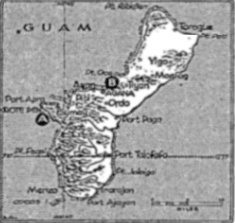The Free Lance-Star (June 23, 1944)
20,000 Japs seen doomed on Saipan
Men are left to fate by fleet routed in fight this week
USPACFLT HQ, Pearl Harbor, Hawaii (AP) –
Twenty thousand Japanese, apparently abandoned to their death by a routed Nipponese fleet, were hit high and low today on Saipan by a U.S. invasion army which now outnumbers the foe.
Sensing almost certain victory in the distant Marianas as the aftermath of a one-sided sea triumph, the reinforced Yanks scaled the heights and probed the flatlands of that island gateway to Japan, China and the Philippines.
The scales were tipped heavily in favor of the United States Monday by “Task Force 58,” a newly-disclosed fast and mighty armada with perhaps 20 of the nearly 100 U.S. carriers in action against Japan.
Saipan’s potential naval support was sent scurrying between Luzon and Formosa into the far China Sea by carrier planes of this specialized group which sank one Japanese carrier, heavily hit three others and damaged a battleship and cruiser. In all, four enemy ships were definitely sunk and 10 others hard hit.
Big assignment
Task Force 58, which Navy officials in Washington said has been assigned “the entire Pacific Ocean to the gates of Japan as its stamping ground,” thus paved the way for a stepped-up drive on Saipan itself. Last night, Adm. Chester W. Nimitz reported that the invasion of that island, 1,500 miles from Tokyo but 3,800 miles from Pearl Harbor, was going well.
Supported by planes operating off captured Aslito Airdrome and outgunning the Nipponese on the ground, the Yanks drove ahead more than a mile on the east side of the island at Magicienne Bay.
In the center, they were scaling 1,540-foot Mount Tapochau. In the southeast tip, they had wiped out half of an unspecified total of trapped Japanese and seized 500-foot Mount Nafutan.
Today Tokyo conceded in a dispatch heard over the German radio that the Yanks are pouring ashore, along with heavy guns, on Saipan.
Nimitz’s communiqué said:
Heavy pressure is being maintained night and day against enemy troop concentrations and defense works by our aircraft, Army, Marine artillery and naval gunfire.
Bombing fails
The only mention of enemy air action was an attempt to bomb U.S. transports but it “did no damage.”
Assessing Monday’s attack far to the west of Saipan on the Japanese fleet, Navy Secretary Forrestal said in Washington:
Our fleet did a magnificent job, but the Navy is not going to be satisfied until the Japanese fleet is wiped out.
He said the Japanese “never came very far to the eastward” and “we were able to send home but one air attack at very long range from our carriers just before dark.”
The dynamite punch of the task force was obviously a painful surprise for the Japanese whose carrier planes, at a cost of 353, superficially damaged two U.S. carriers and a battleship Sunday.
Japs alarmed by Saipan situation
By the Associated Press
Etsuzō Kurihara, chief of the Naval Press Section of Japanese Imperial Headquarters, declared in a formal statement broadcast by Tokyo today that the “battle situation in the Saipan area is the most critical one since the beginning of the war.”
The statement, recorded by the Office of War Information, said a major effort would be necessary to turn back advanced naval elements “centered around more than 20 aircraft carriers and more than a dozen battleships with more than 100 transport ships.”
Kurihara’s statement said:
The enemy’s plan of advance is the greatest since the beginning of the war in the strength of the main force and in the furiousness of the enemy’s fighting morale.
The statement broadcast on the Japanese home radio as well as abroad acknowledged the Saipan operation as an “advance of the enemy into our inner line.”

